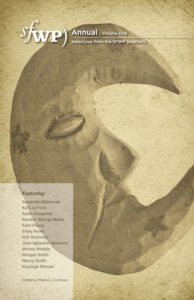 The Santa Fe Writers Project has been home to the published works of many authors since 2002 when founding member Andrew Gifford began the SFWP Journal, the online literary journal component. The journal, now called the SFWP Quarterly, prints the best fiction and creative nonfiction along with book reviews, interviews, and experimental work. In the first volume of the SFWP Quarterly Annual, the editors have compiled twelve of their favorite works of fiction and creative nonfiction since the SFWP Quarterly’s inception in February 2015.
The Santa Fe Writers Project has been home to the published works of many authors since 2002 when founding member Andrew Gifford began the SFWP Journal, the online literary journal component. The journal, now called the SFWP Quarterly, prints the best fiction and creative nonfiction along with book reviews, interviews, and experimental work. In the first volume of the SFWP Quarterly Annual, the editors have compiled twelve of their favorite works of fiction and creative nonfiction since the SFWP Quarterly’s inception in February 2015.
The first five works in the issue are creative nonfiction. The annual begins on a strong note with the work of creative nonfiction by Samantha Edmonds, “How to Be”, a refreshingly modern take on the classic choose-your-own-adventure books. The components of this work are interspersed throughout the volume, allowing the reader to flip to the corresponding page number to read the piece as a whole all at once, or to read the issue in a traditionally linear manner, finding pieces of “How to Be” sprinkled throughout the volume.
While the Edmonds piece sets the tone, each of the subsequent works (just as delightfully diverse both in terms of voice and content) stand well on their own as well, constantly changing the tone of the collection, but never diminishing it.
Randon Billings Noble takes readers on a brief scientific and historical trip to the moon in “Moon and the Man”, reminding us each to contemplate our own place and our role. N.R. Robinson’s “Our Institutions” and Morgan Smith’s “A Member of the Family” both take us into the inhospitable hallways of psychiatric institutions, though in different parts of the continent, told from different perspectives, expressing the similarities and dissimilarities of these facilities through their different perspectives. Kayleigh Wanzer’s final work of creative nonfiction in this anthology, “Thirteen Weeks”, takes readers on a candid journey through the initial thirteen weeks of an unexpected pregnancy, showcasing the effects it can take on the mind and the body in a numbered sequence that reads as much poetry as personal essay.
From this point on the anthology features fiction, each story as varied as the creative nonfiction pieces, and just as powerfully emotive. The reader is taken from a story of family dysfunction in rural Oklahoma in Kelli Jo Ford’s “Terra Firma”, to 17th-century Salem in Sadie Hoagland’s story “Dementia, 1692” about witches and illness, to a gut-wrenching and anxious story about missing a funeral, told in a span of a half hour in Kerri Pierce’s “Better Than Six”. Perhaps the most tragic of all is Atossa Shafaie’s “Wheat to Bread”, the story of a young gay man trying to exist in Iran. The seven fictional stories in the anthology come to a close with Nancy Smith’s “Nightfall”, a story about the end of the world. There is unlikely a better, more fitting way, to end a literary journal but with a doomsday story.
Each piece in this collection packs a solid punch. The works are thoughtful, effective, and showcase the skill and experience of twelve talented writers. There may not be an obvious direct theme holding the anthology together, though indirectly the stories all speak to the idea of social identity and sense of self. The masterful editing in this collection puts “How to Be” first and foremost, but the pieces of that essay rolling throughout the anthology is a reminder to the reader of an individual’s place in the world while it ties the rest of the anthology together in a surprisingly cohesive style. We all are, after all, trying to understand how to be.
SFWP Annual: Volume One: Selections from the SFWP Quarterly
Edited by Melanie J. Cordova
ISBN: 9781939650719









